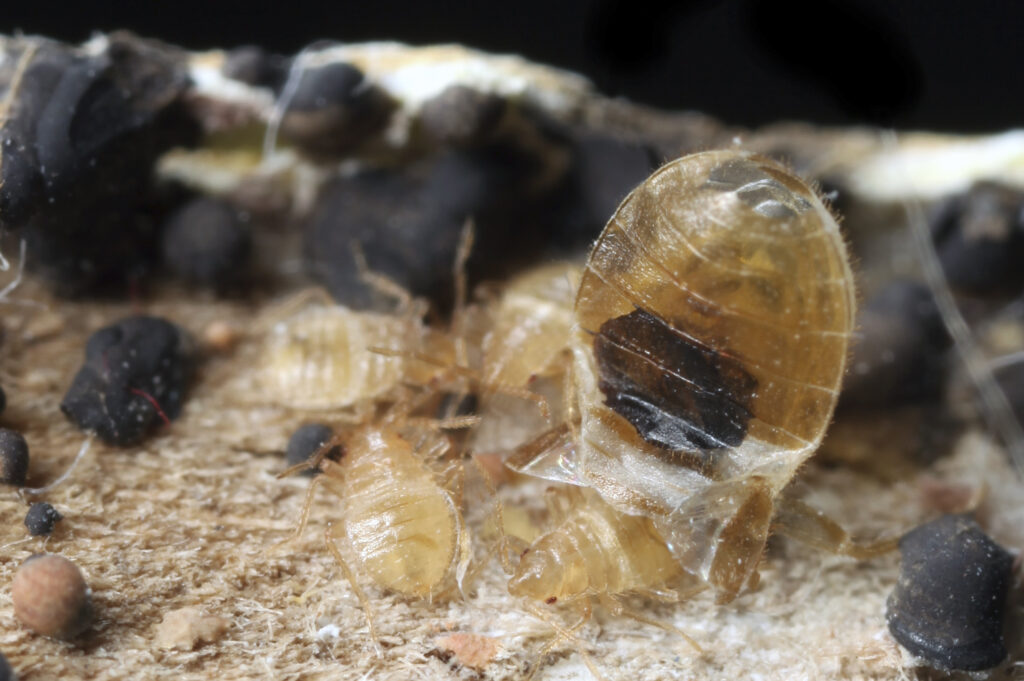Bed Bug Population Calculator

How quickly does a bed bug population grow?
The one thing that everyone seems to ask when they realize they have a bed bug problem, is “when did this problem start?” Or, “How long do you think they have been in my home?” I believe everyone likes to identify the cause of their suffering. Was it a trip to Hawaii? Did it start when cousin XYZ came to stay? Did the infestation start with that super cute nightstand that you purchased from a yard sale and refurbished? The fact is you may never know with 100% certainty where you originally picked up the bed bugs.
For the super sleuths among us you may find the bed bug calculator on this page helpful. Bed bug populations grow at a predictable rate under ideal conditions. Use the calculator below to test a couple scenarios. If you brought home 2 female bed bugs from your trip to Hawaii, how many bed bugs could be in your house now?
Let’s test a scenario:
You and your family when on a glamping trip to the Grand Teton’s National Park. The trip was great, but at night you felt like something was biting you. On the last night of the visit you found a bug in your daughters bed, but didn’t give it much thought. It has now been 45 days since your camping trip and you continue to feel like you are getting bitten at night. After a quick google search your stomach drops when you recognize a picture of a bed bug as the bug you saw in your daughters bed the last night of the camping trip.
Create a hypothesis:
- What if your family brought home 4 adult female bed bugs?
- It has been 45 days since the trip.
Bed Bug Calculator Results
- 112 Bed Bug Eggs
- 248 Nymphs (Nymphs Bites!)
- 4 Adult Bed Bugs. (Adults Bite too!)
Is it possible that the amount of bites and discomfort you are receiving now could be caused by bed bugs you picked up 6 weeks ago? Probably.
There are number of ways for you to use the calculator. We hope you have fun using our bed bug population calculator and we hope it is helpful!
Bed Bug Population Calculator
It is common knowledge that bed bug populations can grow very quickly. We felt it would be valuable to create an interactive calculator that demonstrates how fast a bed bug population can grow under ideal conditions.
New Infestation:
Use this calculator if you want to learn how quickly newly introduced bed bugs can multiply.
Results:
| Total Eggs | Total Nymphs | Total Adults |
|---|---|---|

Bed Bug Eggs
Very tiny, but still visible with the naked eye. Sticky and often found near bed bug fecal matter. Can be found in screw holes, furniture joints, folds of fabric, etc.

Bed Bug Nymphs
After hatching bed bug nymphs will seek out a blood meal. There are 5 nymphal stages and a blood meal is required at each stage.

Bed Bug Adults
Adult bed bugs can move quickly, but will usually just meander. Adult bed bugs can reproduce quickly. A female bed bug can lay more than 200 eggs in a lifetime.
How accurate is this bed bug calculator?
We built this bed bug calculator because we were skeptical of many of the infographics and information floating around the internet regarding how quickly bed bug populations grow. No doubt these infographics were created by well meaning individuals, yet we questioned the accuracy of the information presented. A few of those infographics were built on faulty underlying logic. For example, one such infographic was built using the assumption that an adult female can lay 500 eggs in a lifetime. While I have no doubt that at least one bed bug has laid 500 eggs in its lifetime, it seems unreasonable to assume that every female bed bug will lay 500 eggs in its life. It felt like many infographics were created with the intent to SHOCK the viewer with a huge, barely comprehensible number. We believe the conservative numbers of bed bug population growth are scary enough.
You might be wondering, “Hey Jared, why should we trust your bed bug calculator?”
Great question! Well, first I would tell you the purpose of this bed bug calculator. It was created to model the growth of a bed bug population in ideal conditions. Secondly, I would tell you that we did our homework. We studied the work of experts, we particularly like the information presented by the University of Minnesota and University of Florida. The University and Minnesota states that a female bed bug can lay “200 to 250 eggs in her lifetime. We have submitted our calculator to respected insect biologists for feedback and are committed to improving our calculator based on their feedback. There are so many factors involved in population growth and it would be virtually impossible to track, let alone model the impact of each variable. The intent is to demonstrate growth based on reasonable assumptions and the data available.

